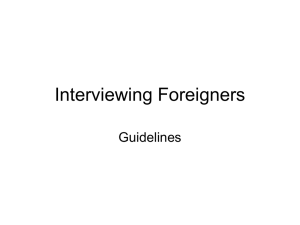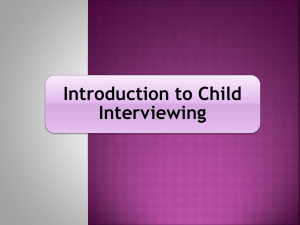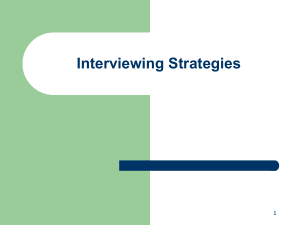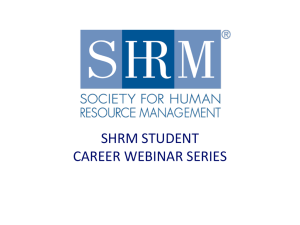Communication Skills for Clinical Practice
advertisement
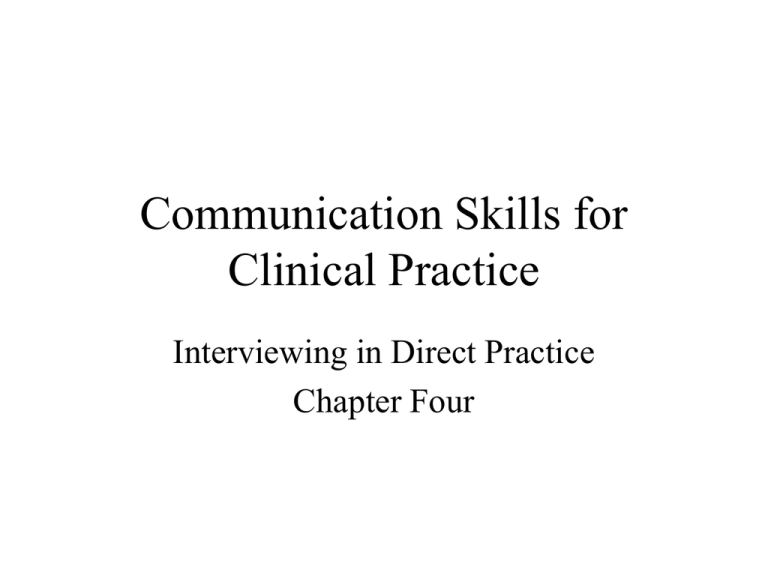
Communication Skills for Clinical Practice Interviewing in Direct Practice Chapter Four The Professional Interview • The interview is the most frequently employed social work skill (Kadushin, 1990). • The professional interview is purposeful. It has a formally arranged meeting time, place and duration. • The worker’s actions must be planned, deliberate, and consciously selected to further the purpose of the interview. The Professional InterviewContinued • It is the worker’s responsibility to assure unity, progression and thematic continuity so that the interview moves toward its goal. • The worker must recognize what is extraneous material and what is pertinent. • The worker must attend to both verbal and nonverbal communication during the interview. • Cultural filters can and do bias the gathering of information, assessment, the choice of appropriate interventions and the ability to establish a working relationship. Skills in Interviewing • The greatest enemy of communication is the illusion of it. (Kadushin, 1990) • Most interviewing techniques are based on the presumption that the client possesses intact cognition and adult language competency. • Interviewing skills may be classified as: (1) Generic-common to all interviews (2) Ethnographic – capable of facilitating communication when cultural differences exist (3) Theory-guided inquiries Communication Formats • Written communication consists of: (1)Client records, (2) Progress notes, (3) Case studies, (4) Case presentations. (5) Intake forms. (6) Transfer summaries and Termination summaries, (7) Documentation for reimbursement by managed care or other third party payers, (8)Affidavits, (9) Expert testimony, and (10) process recordings for purposes of education. • Oral communication occurs in clinical case conferences and team meetings. The worker-client therapeutic session is discussed in chapter six. Process Recordings For purposes of education, students capture the interview in process recordings. Worker-client dialog reflects three social work processes: (1) the enactment of relationship (2) data gathering (for the purpose of assessment) (3) the delivery of theory-based talk therapies as therapeutic intervention Culture Influences Language • Language is first and foremost culturally bound. It is not a neutral medium of communication. • Workers and clients express their ethnicity and worldviews through language. • Before theory-specific interviewing techniques (i.e. empathic responding) can be used, the worker must first learn the cultural context within which clients express such sensibilities. Sapir-Whorf Hypothesis • Language is a behaviorally active agent and a signifier of an individual’s ethnic affiliations. • According to the Sapir-Whorf hypothesis (Green 1995) the real world is constructed according to the received linguistic traditions of a culture. • We see, hear and otherwise experience as we do because the language habits of community predispose certain choices of interpretation. Mental Lexicons • According to Aitchison (1983) words stand as a proxy for specific ideas, relationships and actions. • The human mind organizes information by filtering it through linguistic mazes that constitute a cultural template or mental lexicon. • Words like the “flu” link to different mental lexicons about what causes it, how one knows one has it, how benign or dangerous it is and how it should be treated. Individuals do not share the same mental lexicon on the “flu”. Encoding, Decoding and Processing in the Interview • The interview involves three processes : (1) transmitting (encoding) receiving (decoding) and processing communication. • Encoding: how the sender encrypts the message • Decoding: how the message is received • Processing: how the received message is linked to a mental lexicon to give it meaning • Being aware of one’s own and another’s filters is an intellectually and emotionally intensive activity. What is sent is not necessarily received. Culture and its Impact on the Interview Process • Encoding, decoding and processing are affected by one’s culture and experiential history. • Words reveal a person’s storehouse of information about how the world is organized and how it operates. • Words impose an order on perception, create categories of things and suggest something of what the categories might be worth (values). • To be effective, practitioners must be aware of worker-client differences and similarities Worker-Client Similarities and Differences • Empirical evidence indicates that worker-client matching is no guarantee that a working relationship will be established; nor is there empirical evidence to suggest that worker-client differences prevent the establishment of a working relationship. • It is important however to discuss attitudes and stereotypes about race, color, ethnicity, class, gender, sexual orientation, and handicapping condition when establishing a worker-client relationship because cultural differences influence language and the development of mental lexicons Errors of Assumption • To assume that race and ethnicity make no difference because we are all human is an error. • To assume that differences are so great that they will prevent rapport or communication is an error. • To assume that similarity and shared language produce a shared reality is an error; similar users of the same language create alternative realities. Non-Verbal Communication • Like verbal communication, non-verbal communication is culture-bound. • Non-verbal communication consists of the use of space, eye contact, gestures, silence, orientation to time (Ivey, 1994). • Competent practice requires all workers to be culturally sensitive and culturally responsive Ethnically Sensitive and Culturally Responsive Practice 1. Requires ethnic sensitivity i.e. Substantive descriptive knowledge specific to different cultural, racial, and ethnic groups (Devore and Schlesinger, 1998) 2. Requires development of and use of specific ethno-psychotherapy models (Vargas and KossChioino, 1992) 3. Requires skills in ethnographic interviewing. Ethnographic Interviewing • There is no single standardized procedure. • The worker focuses on cover terms: casual phrases and words that are familiar to the client but that standout to the worker as a cultural outsider. • The worker uses the client as guide to acquire descriptors (of cover terms) in order to acquire a client-taught ethnographic mental lexicon Ethnographic InterviewingContinued • The purpose of ethnographic interviewing is to gather ethnographic data specific to understanding and defining the needs of the client as well as defining interventions that the client regards as acceptable. • By using the client as a cultural guide, the worker structures the interview and acquires a clienttaught ethnographic vocabulary and mental lexicon. Foreign Language The Use of Translators • Not all social work can be done in English. • When the worker is not fluent in the language of the client and the client speaks little or no English, is essential to use a translator. • It is important for the worker to understand the language of illness and pain as well as the language of strengths in the culture of the client. Using a Translator • When an agency serves a client population characterized by one or more foreign languages, it is critical that the agency hire professionals with foreign language fluency or provide the worker with access to trained translators. • It is the agency’s and the worker’s responsibility to overcome language barriers. • Kadushin offers several guidelines when using a translator. Guidelines for Using a Translator • Do not use a member of the client’s family. This often violates a kinship and power structure. • When using a translator, the worker should look at and speak to the client. • The interview should be kept short and there should be frequent summaries to check for understanding. • A summary of the interview should be written as soon as possible after the interview. Selecting a Translator • Selecting a translator is more complex than language fluency. • Many cultural groups have norms against prying and an untrained translator, though fluent, may sanitize or shield the questions and answers. • A trained translator is fluent and will translate accurately and fairly both side of the dialog. Generic Interviewing Skills • All types of interviews use open and closedended questions. • Open-ended questions: phrased to elicit unrestricted information i.e. “tell me about..” • Closed-ended questions: phrased to elicit specific and limited information i.e. “what is your date of birth?” “are you employed?” Generic Interviewing SkillsContinued Several techniques are used to facilitate openended questions: • Prompting: nodding, leaning forward, • Furthering: and then.. and you…after which… • Paraphrasing: You felt her comment was disrespectful? • Checking: do I understand correctly that … Theory-Guided Interview Techniques • Any theory-based line of inquiry must be critically examined for cultural bias. • Theory-guided lines of inquiry order perception create categories of things and suggest something of what the categories might be worth (values). • A theory-based line of inquiry directs the workerclient dialog in a manner consistent the premises and concepts of the theory. • Theory-based lines of inquiries occur at each step of the decision tree Psychodynamic Interviewing Techniques • Psychodynamic interviewing techniques are used in step five of the decision tree to deliver a specific model of talk therapy designed to bring about individual change. • Psychodynamic theory-based techniques are based on the premise that all behavior (including verbal and nonverbal communication) is both conscious and unconscious. • Psychodynamic theory-based techniques focus on vocalizations, pauses, inflections, tone and amplitude. Psychodynamic Interviewing Techniques-Continued • Psychodynamic theory-based techniques are based on the premise that encoding and decoding is selective; what is perceived as threatening will be ignored or rearranged. • Psychodynamic theory-based techniques focus on the use of defense mechanisms i.e. hearing the opposite of what is said, projection of thoughts or feelings, mistaking who said what, discrepancy between verbal and nonverbal behavior • Psychodynamic theory-based techniques focus on manifest and latent content i.e. what is said and what is said indirectly or left unsaid. Psychodynamic Interviewing Techniques-continued • Psychodynamic interviewing techniques probe for feelings and cognitions. • Psychodynamic interviewing techniques create, through empathic responding, a therapeutic relationship capable of being both a holding environment (for emotions and impulses) and a corrective emotional experience. • Psychodynamic interviewing techniques probe the past (there and then) and the present (here and now). Psychodynamic Interviewing Techniques-Continued • Psychodynamic theory-based techniques make explicit what is often recognized but left unstated (interpretation and/or confrontation). • Psychodynamic theory-based techniques probe relationships; those significant to the client in the past, concurrently, and in the here and now of the therapeutic relationship. Interviewing to Determine Eligibility for Concrete Services • Structure-functional theory guides interviewing techniques used to document need and determine eligibility for concrete services according to program regulations. (Step Three of the Decision Tree) • Theory-guided techniques rely on closed ended questions to elicit facts relevant to the establishment of need for specific resources. • Theory-guided techniques rely on closed ended questions to determine eligibility consistent with program regulations. Interviewing Behavior Modification • As a theory-based line of inquiry, behavior modification includes eliciting information on: (1) frequency of the behavior –baseline (2) antecedent cues (Stimulus/triggers)-classical conditioning (3) consequent events (Responses/reinforcers operant conditioning • This line of inquiry is appropriate when behavior modification is the talk therapy model of choice. Strengths-Based Interviewing Theory-Based Talk Therapy • Another theory-based line of inquiry is Strengthbased. • This line of inquiry probes for goals (i.e. the miracle question) rather than past events. • Probes for coping skills (what worked when faced adversity before) • Probes for exceptions (when things were going well) • Probe for strengths and informal resources in the client’s social network. Interviewing with Special Populations • Students often work with populations that do not have adult language competency i.e. infants, children, adolescents, less verbal clients, clients whose capacity to communicate is compromised by physical or mental illness. • Communication and therefore interviewing can be affected by developmental stage, physical diseases such as Alzheimer’s disease or dementia as well as by severe mental illness marked by delusions and hallucinations Interviewing Children • Infants and children have experiential histories long before they have the language skills to capture and convey it. • “Interviewing” infants and children consists of observing their behavior and language and placing it within developmental norms. • Parents and caregivers are interviewed as collateral sources when the client is an infant or child. Theory-Based Lines of Inquiry For Interviewing Children • Lines of inquiry are based on theories of normal and abnormal growth and development. • Children should be assessed for language development (expressive and receptive), speech and hearing, intellectual functioning, development of fine and gross motor skills, development of relationships (attachment, interpersonal skills) and emotional development. • Child’s play is considered a form of communication Child’s Play • Child’s play may be assessed according to Piaget’s cognitive developmental stages: sensori-motor, pre-operational, concrete thinking and formal operational thought. • Play may be assessed using psychodynamic theory to determine emotional development i.e.focus on fantasy and magical thinking. • Play may be regarded as an accurate reflection of parent-child interaction (may indicate possible child abuse – Structure-functional theory). Child’s Play-Continued • Play may be considered a forum for socializing children to the norms of cooperation, sharing, and self control (Socialization theory) • Play may be considered a forum for teaching children life skills (i.e. playing with dolls, cars, trucks, building materials, art materials, body skills i.e. sports, team play etc) • Play may be considered a recreational forum for teaching children how to have fun and enjoy life. Adolescence A Developmental Stage • • • Adolescence is a developmental stage. Theories of normal and abnormal adolescent growth and development are used to guide inquiries. Psychodynamic theories inform inquiries related to personality, states and traits, aspirations and goals. Ego identity Symbolic interaction theory and socialization theory inform lines of inquiries related to social identity and social interaction as do theories of deviance, difference and power. Adolescence A SubCultural • Adolescence is a culture defined by the historical period within which it occurs. • Adolescence also consists of several subcultures, depending upon an adolescent’s ethnic and racial identity. • Theories related to reference group identity, minority/majority status, oppression and discrimination guide inquiries. Knowledge of group dynamics is important. • Ethnographic techniques can be put to excellent use when interviewing adolescents. Interviewing Adolescents Techniques • Do not use the terminology of the adolescent. • Use the adolescent as a cultural guide and phrase inquiries in terms of a generalized adolescent i.e. “what are adolescents thinking when they..”; What do adolescents like about (this) band, these lyrics • When interviewing adolescents, encourage the narrative. • Avoid power struggles if possible. Remember a student interviewer cannot make an adolescent talk even if a process recording is due. Interviewing the Chronically Mentally Ill Client • Students must be prepared to interview a client assessed with chronic mental illness. • This requires knowledge of mental illness, including those manifestations of the illness that are likely to impact the interview process. • The interview may be impacted by the presence of hallucinations, delusions, perseveration, loose associations, word salad, stream of consciousness, word paucity, anxious or depressed affect, impulsivity, and/or acting out behavior. Interviewing the Chronic Mentally Ill-Continued • Students must be aware of the seriousness (or lack thereof) of the disorder and its potential for flareup. • Student’s must be aware of the effect of medications on the client. • Students must not over-react to the florid aspects of client dialog which may contain violent or sexual content. • Students must be able to assess risk in the interview situation and take safety precautions as outlined during agency student orientation. Interviewing Clients Who are Non-Verbal or Low-Verbal • Students are often not clear about the purpose of the interview when they are sent to interview a client with non-verbal, low-verbal, or incoherent speech patterns. • Expressive language may be compromised by physical illness (Alzheimers disease) or mental illness (delusions and hallucinations). • Students must be clear about the purpose of the interview. Following an initial interview, the purpose of the interview must go beyond simply observing symptom manifestation. Programming as Intervention for Low Verbal Clients • Students may use programming techniques when working with clients who have impaired or low verbal capacities. • Program techniques may consist of: listening to music, going for walks, baking, decorating a room, reading to them, looking through photo albums, sharing art, putting on nail polish etc. • The agency, the classroom instructor and the student must be clear as to the purpose of such interventions and their expected outcomes.
